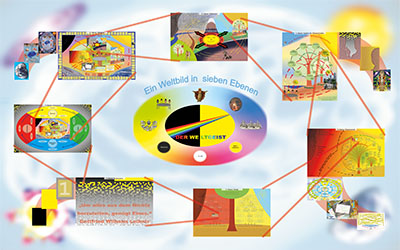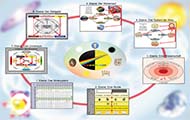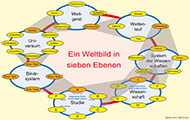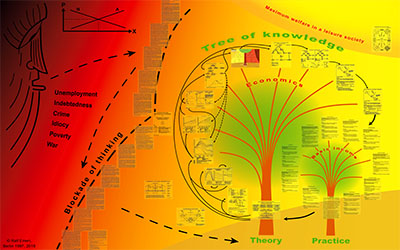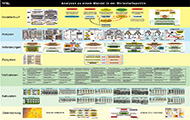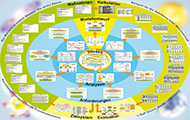1. A Seven-Level World View and
2. Studies of Economic Change
The book to this website is now available in bookstores! (only in german)
Der Weltgeist. Ein Weltbild in sieben Ebenen.
Eine Interpretation des Verses von Gottfried Wilhelm Leibniz:
"Um alles aus dem Nichts herzuleiten, genügt Eines."
Ralf Einert Verlag. Berlin 2024. ISBN 978-3-9826397-0-3. Price 22,00 Euro.
Softcover. 128 pages thereof 24 double-page colour illustrations and 22 additional colour graphics.
Orders via bookstores or via info@der-weltgeist.de or via the order form.

Reviews from ChatGPT, among others: Click here!
Impressions from the Leipzig Book Fair 2025:
Welcome to the Website "THE WORLD SPIRIT"!
Our imaginations of the world and our consciousness determine mainly the criteria the economic rules are deduced from. But the globalisation of the world economy reveals the failure of these rules. Nothing remains as before after the actual financial and economic crisis. More and more people are excluded from the use of the social structures which are factors of production as well.
A Seven-Level World View as an artificial transformation of a philosophical idea opens new horizons. It helps to recognize how the "One" can explain everything or how the logical structure of the universe can be thought. The author provides a new imagination of the world: The seven levels form a circle. Therefore an endless "Voyage through the Universe" arises.
The Studies of Economic Change as an exampel of a science offer a different perspective. Not only philosophers should be concerned by a lack of conviction or trust for their intellectual amusement. Even supposed economic laws have to be proven critically. You will see how chains of causation which are accepted as true can be switched to the opposite and what consequences have to be deduced.
Feel free to chose between the sensual experience or the intellectual challenge!
Please click on one of the images to select your favourite subject - or change to the alternative starting page!
The sensual experience:
A Seven-Level World View
from the general ...
The "Seven-Level World View" is the artificial realization
of a philosophical idea at the borderline between
science and art as well as theory and practice.
Experience how the binary code leads to scientific studies, how these
lead to a science, how this leads to the system of science, how this leads
to the history course, how this leads to the world spirit, and how this
leads to the universe, which is based on "All and Nothing" (Leibniz).
Alternative starting page
The intellectual challenge:
Studies of Economic Change
to the particular ...
The "Studies of Economic Change" give the evidence for
the banal und absurd sounding theses that the working
hours must be reduced and the wages must be increased.
Declining economic growth rates due to the "law" of diminishing
marginal utility meet with increasing labour productivity rates due to
the idea of the evolution theory. The alternatives are maximum welfare
in a leisure-oriented society or full employment connected with poverty.
Alternative starting page
ALL FROM NOTHING AND LIGHT

An interpretation of the sentence of Gottfried Wilhelm Leibniz: "For all to spring from nothing a oneness suffices."
Basic Income
With the support of diverse analyses (assumptions, demography, unemployment, worst case, life cycle, labour demand, labour market, inequality) it is shown that we have to work less, earn more, and be socially secured.
These goals can be reached by the introduction of a basic income in the amount of 60% of the average wage resp. 33% of the GDP in combination with an income tax of 40% for everybody for everything plus a social insurance payment between 0 an 25% without limit for employees and employers depending on working hours and employment. The basic inocme replaces the retirement and unemployment payments. It is financed by the increase of the inheritance tax, the eco tax, the value added tax, the property tax, the capital return tax, the Tobin tax, and the decrease of the bureaucracy. Additional measures are the increase of the minimum wage and a higher degree of flexibility concerning the working hours to increase the productivity.
The consequences of the introduction of a basic income are: the avoidance of poverty and social separation, the creation of a real market for labour, the maintainance of the performance principle, the increase of the purchasing power of the lower income groups, the ensurance of the sustainability by the correlation to the GDP, the democratization of the decision about the amount of the growth rate, the renewance of family peace by abolishing the necessity to pay for children and expartner, the renouncement of the civil marriage, the increase of the birth rate, the healing of mental illness, the decrease of the lack of houses in cities, the revival of rural areas, the abolition of employment agencies and the pension insurance, the reduction of tax offices, and the decrease of the share of capital income.
IMPRESSIONS
OFFER
I offer multimedia ways of gaining knowledge with the support of lectures about the basic income, PowerPoint presentations about economic policy, the animation: "The Voyage through the Universe", keynote speaches about several topics, and exhibitions with interactive use of the samples. It is shown how five degrees of complexity lead to populism and how you can surve through the "Seven Level World View" in three dimensions.
Materials are artprints, a hard foam sheet with 235 file cards, ebooks, a video animation, audio books, websites, and PowerPoint-Presentations.
Please find further information under: analyse-planung-beratung.de
AUDIO BOOKS
Studies of economic change or: A society without economic growth is possible
Introduction
Chapter 1: Assumptions
Chapter 2: Demography
Chapter 3: Unemployment
Chapter 4: Worst Case
Chapter 5: Life Cycle
Chapter 6: Wage Spiral
Chapter 7: Labour Demand
Chapter 8: Labour Market
Chapter 9: Inequality
Goals and Measures




